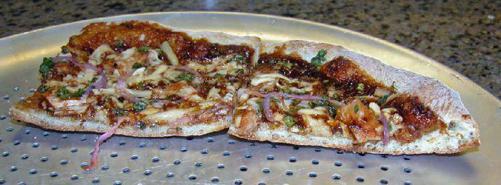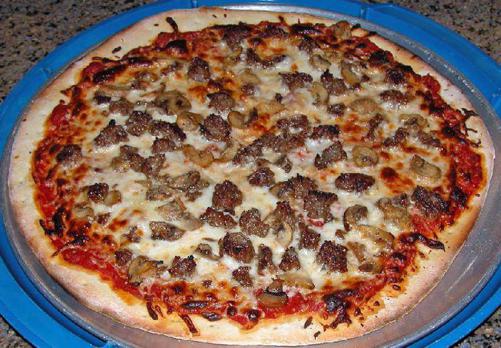Passionate About Pizza: Making Great Homemade Pizza (32 page)
Read Passionate About Pizza: Making Great Homemade Pizza Online
Authors: Curtis Ide
Tags: #Baking, #Cookbook, #Dough, #Pizza

Shaping
–
California-style Pizza is hand stretched into shape. Two California-style Pizzas can fit easily on the full size pizza peel (and the baking stone) together. Stretch one of the four balls of dough into an eight-inch circle or oval using the method described in the Hand Stretching Individual Pizzas section in the preparation techniques chapter (see
page 64
). Once the dough is close to the desired size, carefully lay the dough onto the prepared pizza peel covering one-half of the peel. Gently configure the dough into its final shape. Now stretch out a second dough ball and place it on the peel next to the first pizza. Arrange the pizzas so that they fit without overlapping each other (it is okay if they touch). With care, you should be able to slide both pizzas into the oven and onto the stone at the same time.
Assembly
– Spread an even layer of barbecue sauce (a quarter to third cup) over the pizza to within half an inch of the edge. The layer of sauce should be just thick enough so that you do not see bare spots through the sauce, but be careful not to use too much sauce. Spread one fourth of the chicken (or duck) evenly over the pizza and sprinkle one fourth of the cheese on top. Place a few rings of onion on top of the cheese and sprinkle some cilantro on top of it all. After getting all the toppings on the pizza, it will look pretty tall. Do not worry, things will settle down just right as the pizza bakes!
Baking
– Slide the two pizzas onto a baking stone preheated to 500˚ and bake for ten to twelve minutes. The actual baking time may vary from eight to fourteen minutes depending on the oven, but be careful not to bake too long. You want to bake the pizza so that the crust is nicely browned and crunchy-chewy, but not overdone. In addition, the toppings should be heated through with the cheese and sauce bubbling slightly (it will almost look like it is boiling) over the whole surface of the pizza. This ensures that the toppings and sauce heat to the right temperature and that the crust cooks through.
Repeat the stretching, assembly, baking process for the other two pizzas. You can serve the first two pizzas and share them or you can wait until you cook all four before serving. This is one spot where a warming drawer helps!
Serving
– After removing the pizzas from the oven, brush the edges of the pizza crust with a little extra virgin olive oil, if desired. Put the pizzas on a serving tray and let them stand for a few minutes on a trivet until the cheese stops bubbling and the pizza cools slightly. This allows the toppings and cheese to set prior to cutting. Cut the pizzas into manageable size slices and serve while still warm.
Variations
Dough
– Basic Pizza Dough, California-style Sourdough Dough, Half Wheat Dough, Herman Sourdough Dough, New York-style Dough, Rye Dough, Whole Wheat Dough, Slow Rise Dough
Sauce and Toppings
– You can substitute duck for the chicken in this recipe.
In fact, you can put virtually anything on a California-style Pizza; the Californians sure have! Try for bold and innovative combinations. You do not have to make all four pizzas with the same toppings.
Assembly and Baking
– You can change the shape of the pizzas to your taste. Keep them individually sized if you want it to remain a California-style pizza. You can assemble and bake the pizzas on pizza screens. Of course, you can make one big pizza; it is your pizza!
Whole Wheat Pizza
Who says that whole grain food has to be boring? This pizza shows how to put rich tastes together with whole wheat for a sassy pizza taste sensation.
It takes a little extra care to make a great pizza using whole wheat dough. First, the pizza dough made with whole wheat must maintain enough of the body and handling characteristics of regular pizza dough so that you get pizza crust rather than bread. To do this, you must use a mixture of whole-wheat flour and wheat gluten. The gluten can come in the form of vital wheat gluten or it can come from high-gluten flour or bread flour. Second, you need to have richly flavored toppings to complement the stronger taste of the whole-wheat crust.
When shaping whole-wheat dough, you must be careful and gentle because the dough tears more easily than other types of dough.
Sassy Southwest Pizza
Makes one fourteen to sixteen inch pizza.
1/2 pound skirt steak
1 recipe Whole Wheat Dough (
page 100
) or Half Wheat Dough (
page 99
)
olive oil
1 cup Sassy South of the Border Sauce (see recipe
page 120
)
8 ounces Chihuahua (or Monterrey Jack) cheese, cut into small cubes dried cilantro or parsley
unbleached all-purpose flour (for kneading and shaping)
Toppings
– Place the skirt steak on a medium-hot grill and cook completely, seasoning with salt and pepper while cooking. Cut the cooked steak into thin strips across the grain and cut these into small bite-sized pieces; this makes it easier to spread on the pizza. After you cut the steak, set it aside.
Resting
–
After the dough has risen, punch it down with one fist, take it out of the bowl, and knead it briefly (about one minute) without adding any flour, to release the large air bubbles. Make a dough ball than shape it into a flat circle about one inch thick. Sandwich the dough between two layers of plastic wrap and let it rest briefly on the counter for five to ten minutes before shaping it.
Shaping
–
This pizza comes out best when hand stretched. Be gentle when stretching this dough because the whole-wheat flour makes the dough more prone to tearing. Carefully stretch or roll the dough to the desired shape using the technique described in the preparation techniques chapter (see pages
58
).
Once the dough is close to the desired size, carefully lay the dough onto the prepared pizza peel, pizza screen, or pizza pan. Gently configure the dough into its final shape. Remember not to squash the edge!
Assembly
– Lightly brush the dough with olive oil (including the edge) and then spread an even layer of sauce over the pizza up to edge. The onions in the sauce may make it hard to spread evenly; do not worry about it. Evenly sprinkle the skirt steak over the sauce and then cover it with the cheese. Sprinkle with herbs, if desired. The sauce and toppings will migrate toward the center, so you should put a little less in the center; otherwise, the cooked pizza may be soggy in the center.
Baking
– Bake at 500˚ for eleven to thirteen minutes. The actual baking time may vary from eight to sixteen minutes depending on the oven, but be careful not to bake too long. You want to bake the pizza so that the crust is nicely browned and crunchy-chewy, but not overdone. In addition, the toppings should be heated through; the cheese and sauce should be bubbling slightly (it will almost look like it is boiling) over the whole surface of the pizza. This ensures that the toppings and sauce heat to the right temperature.
Serving
– After removing the pizza from the oven, let it stand for a few minutes on a trivet until the cheese stops bubbling and the pizza cools slightly. This allows the toppings and cheese to set prior to cutting. Cut the pizza into manageable size slices and serve while still warm.
If you have one, serve the pizza on a perforated pan. The holes in the pan let steam and sauce out so that the crust does not become soggy.
Variations
Dough
– Half Wheat Dough, Whole Wheat Dough
Sauce
– Basic Pizza Sauce, Chicago-style Sauce, Sweet Pizza Sauce, Mexican Chile Sauce, Sassy South of the Border Sauce, Vegetarian Eggplant Sauce. Any other strong or bold tasting sauce.
Toppings
– Use strong or bold tasting toppings.
Assembly and Baking
– You can assemble and bake this pizza on either a pizza peel or a pizza screen. If you prefer thicker crust, you can let the shaped dough rise for a few minutes before assembling the pizza.
Cracker Crust Pizza
It just does not get much thinner than this. Cracker Crust Pizza is very thin and crispy with little tiny air bubbles throughout the crust just like saltine crackers. In most pizzerias in the Midwest, if you ask for thin crust pizza, this is what you get. If you are in Chicago and order this (or any) pizza without sausage on it, they look at you a little funny and they know you are not from around there.
Cracker crust pizza is popular in family-style or all-you-can-eat buffet pizzerias because the dough is very easy to shape. They roll it out thin with no formed edge. The lack of a formed edge allows the pizza maker to cut the rolled-out dough into any desired shape or size. For example, they may roll out the dough into an irregular shape then cut it into a perfect circle using a pattern. Some pizzerias even cut it into interesting shapes near the holidays; a Valentine pizza in the shape of a heart is quite common.
Cracker crust pizza is made in the home by poking the dough with the tines of a fork (this is called docking) to make little holes. These holes allow the carbon dioxide produced by the yeast to escape during cooking so that the crust stays thin. You can use a dough docker like the one the professionals use if you have one. In addition, this dough has no sugar to keep the multiplication of the yeast to a minimum, which helps keep the crust thin. Do not feel that you must purchase a dough docker in order to make this pizza. I used the tines of a fork very successfully for years before I bought a dough docker.
If you have ever noticed the little holes in a cracker, you are seeing them for a reason; they keep the cracker from puffing up too much. We make little holes in the cracker crust pizza for the same reason. They are actually there to connect the top surface of the crust to the bottom surface. They just turn into holes because you have to press the two surfaces together.



